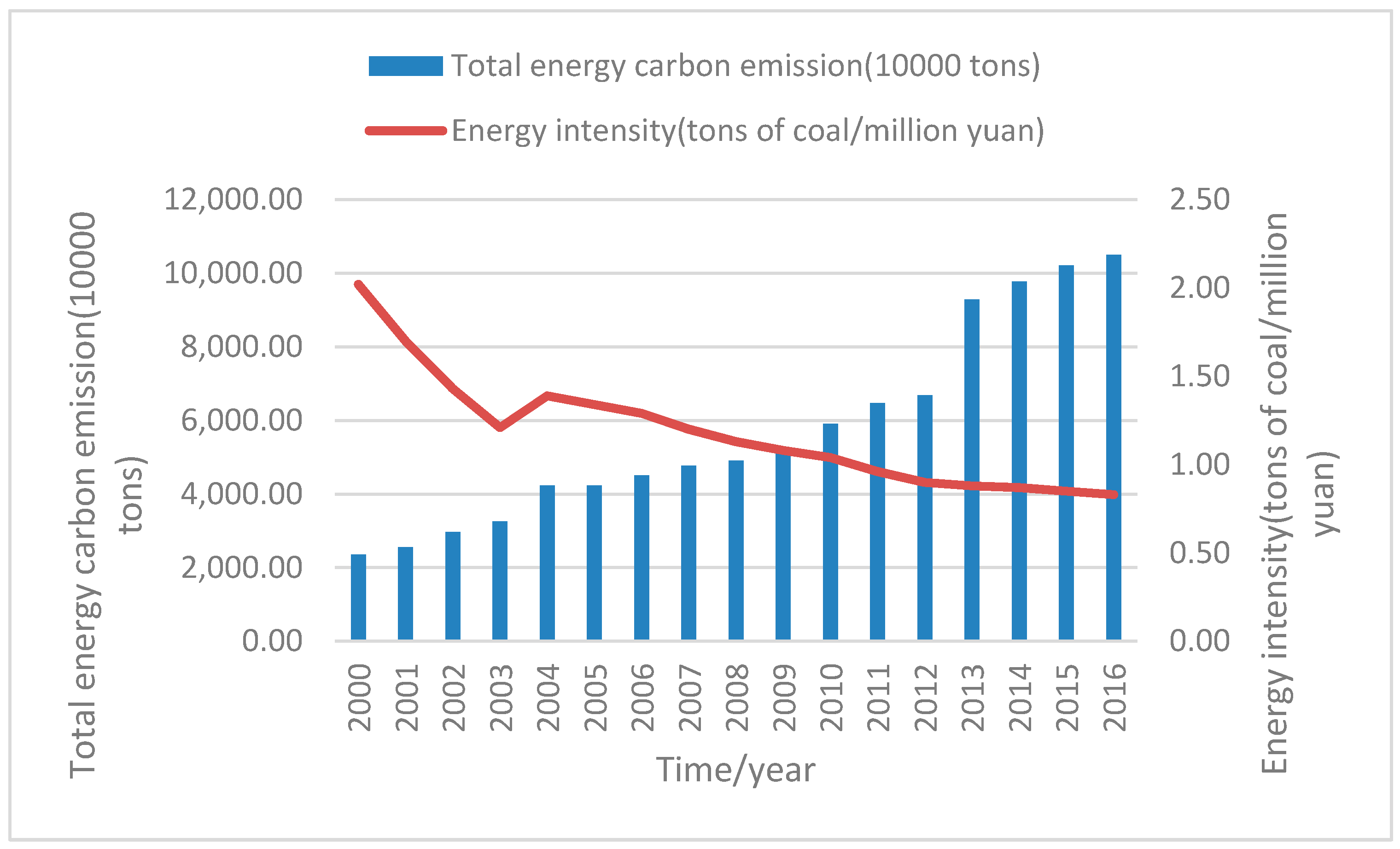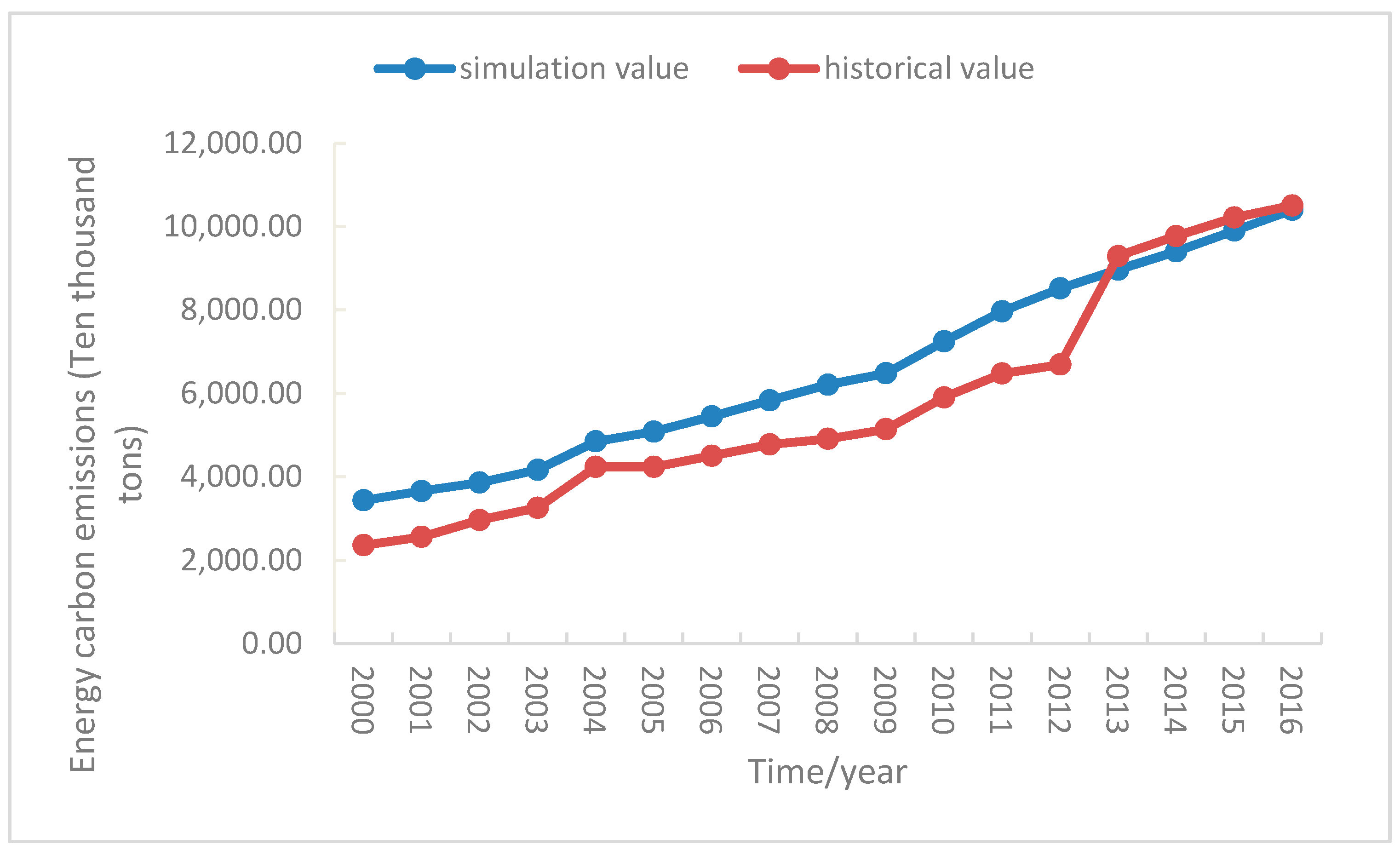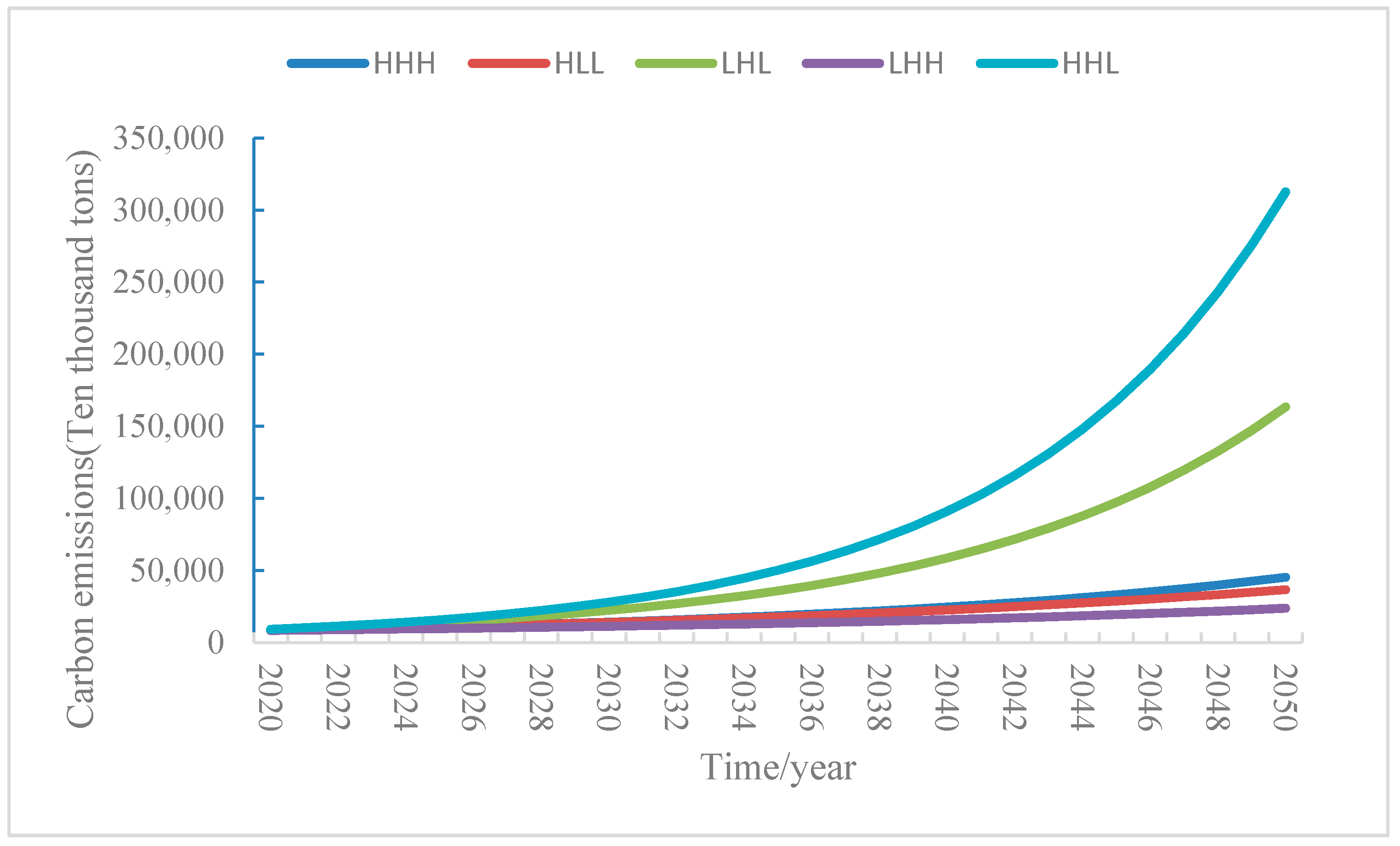Trends and Driving Forces of Carbon Emissions from Energy Consumption: A Case Study of Nanjing, China
Abstract
:1. Introduction
2. Materials and Methods
2.1. Study Area
2.2. Methodology
2.2.1. Calculation Method for Energy Carbon Emissions
2.2.2. STIRPAT Model
2.2.3. Ridge Regression
2.3. Data Sources
3. Results
3.1. Energy Carbon Emissions and Energy Intensity
3.2. STIRPAT-Based Modeling
3.3. Analysis of STIRPAT Model Results
3.4. Scenario Analysis
4. Discussion: How to Produce a Win–Win Situation for Urban Development and Reduction of Carbon Emissions
5. Conclusions
Author Contributions
Funding
Acknowledgments
Conflicts of Interest
References
- Dhakal, S. Urban energy use and carbon emissions from cities in china and policy implications. Energy Policy 2009, 37, 4208–4219. [Google Scholar] [CrossRef]
- Zhang, Y.-J.; Da, Y.-B. The decomposition of energy-related carbon emission and its decoupling with economic growth in china. Renew. Sustain. Energy Rev. 2015, 41, 1255–1266. [Google Scholar] [CrossRef]
- Stern, D.I. The rise and fall of the environmental kuznets curve. World Dev. 2004, 32, 1419–1439. [Google Scholar] [CrossRef]
- Menegaki, A.N. Growth and renewable energy in europe: A random effect model with evidence for neutrality hypothesis. Energy Econ. 2011, 33, 257–263. [Google Scholar] [CrossRef]
- Magazzino, C. The relationship among economic growth, CO2 emissions, and energy use in the apec countries: A panel var approach. Environ. Syst. Decis. 2017, 37, 353–366. [Google Scholar] [CrossRef]
- Magazzino, C. Co2 emissions, economic growth, and energy use in the middle east countries: A panel var approach. Energy Sources Part B 2016, 11, 960–968. [Google Scholar] [CrossRef]
- Magazzino, C. Economic growth, CO2 emissions and energy use in the south caucasus and turkey: A pvar analyses. Int. Energy J. 2017, 16, 153–162. [Google Scholar]
- Moya, J.A.; Pardo, N.; Mercier, A. The potential for improvements in energy efficiency and CO2, emissions in the eu27 cement industry and the relationship with the capital budgeting decision criteria. J. Clean. Prod. 2011, 19, 1207–1215. [Google Scholar] [CrossRef]
- Wang, Z.; Wang, C.; Yin, J. Strategies for addressing climate change on the industrial level: Affecting factors to CO2, emissions of energy-intensive industries in china. Nat. Hazards 2015, 75, 303–317. [Google Scholar] [CrossRef]
- York, R.; Rosa, E.A.; Dietz, T. Bridging environmental science with environmental policy: Plasticity of population, affluence, and technology. Soc. Sci. Q. 2002, 83, 18–34. [Google Scholar] [CrossRef]
- Al-Mulali, U.; Ozturk, L. The effect of energy consumption, urbanization, trade openness, industrial output, and the political stability on the environmental degradation in the mena (middle east and north african) region. Energy 2015, 84, 382–389. [Google Scholar] [CrossRef]
- Munir, K.; Ameer, A. Effect of economic growth, trade openness, urbanization, and technology on environment of asian emerging economies. Manag. Environ. Qual. Int. J. 2018, 29, 1123–1134. [Google Scholar] [CrossRef]
- Wang, S.; Li, Q.; Fang, C.; Zhou, C. The relationship between economic growth, energy consumption, and CO2 emissions: Empirical evidence from china. Sci. Total Environ. 2016, 542, 360–371. [Google Scholar] [CrossRef] [PubMed]
- Han, Y.F.; Li, Q. Analysis on influencing factors of energy intensity in anhui province. Appl. Mech. Mater. 2012, 253–255, 203–206. [Google Scholar] [CrossRef]
- Xu, S.-C.; He, Z.-X.; Long, R.-Y. Factors that influence carbon emissions due to energy consumption in china: Decomposition analysis using lmdi. Appl. Energy 2014, 127, 182–193. [Google Scholar] [CrossRef]
- Lazarou, S.; Ekonomou, L.; Dagoumas, A. Correlation between representative concentration pathways and paris agreement. Int. J. Renew. Energy Res. 2018, 8, 929–940. [Google Scholar]
- Huang, R.; Zhang, S.; Liu, C. Comparing urban and rural household CO2 emissions—Case from china’s four megacities: Beijing, tianjin, shanghai, and chongqing. Energies 2018, 11, 1257. [Google Scholar] [CrossRef]
- Liang, Q.-M.; Fan, Y.; Wei, Y.-M. Multi-regional input–output model for regional energy requirements and CO2 emissions in china. Energy Policy 2007, 35, 1685–1700. [Google Scholar] [CrossRef]
- Chen, Y.; Lin, S. Decomposition and allocation of energy-related carbon dioxide emission allowance over provinces of china. Nat. Hazards 2015, 76, 1893–1909. [Google Scholar] [CrossRef]
- Lu, W.; Chen, C.; Su, M.; Chen, B.; Cai, Y.; Xing, T. Urban energy consumption and related carbon emission estimation: A study at the sector scale. Front. Earth Sci. 2013, 7, 480–486. [Google Scholar] [CrossRef]
- Akpan, G.E.; Akpan, U.F. Electricity consumption, carbon emissions and economic growth in Nigeria. Int. J. Energy Econ. Policy 2012, 2, 292–306. [Google Scholar]
- Dykhuizen, D. Selection for tryptophan auxotrophs of escherichia coli in glucose-limited chemostats as a test of the energy conservation hypothesis of evolution. Evolution 1978, 32, 125–150. [Google Scholar] [CrossRef] [PubMed]
- Magazzino, C. The relationship among real gdp, CO2 emissions, and energy use in south caucasus and turkey. Int. J. Energy Econ. Policy 2016, 6, 672–683. [Google Scholar]
- Magazzino, C. The relationship between CO2 emissions, energy consumption and economic growth in italy. Int. J. Sustain. Energy 2016, 35, 844–857. [Google Scholar] [CrossRef]
- Wang, S.; Fang, C.; Wang, Y.; Huang, Y.; Ma, H. Quantifying the relationship between urban development intensity and carbon dioxide emissions using a panel data analysis. Ecol. Indic. 2015, 49, 121–131. [Google Scholar] [CrossRef]
- Unruh, G.C. Understanding carbon lock-in. Energy Policy 2000, 28, 817–830. [Google Scholar] [CrossRef]
- Dietz, T.; Rosa, E.A. Effects of population and affluence on CO2 emissions. Proc. Natl. Acad.Sci. USA 1997, 94, 175–179. [Google Scholar] [CrossRef] [PubMed]
- York, R.; Rosa, E.A.; Dietz, T. Stirpat, ipat and impact: Analytic tools for unpacking the driving forces of environmental impacts. Ecol. Econ. 2003, 46, 351–365. [Google Scholar] [CrossRef]
- ArthurE, H.; Robert, W.K. Ridge regression: Biased estimation for nonorthogonal problems. Technometrics 2012, 42, 80–86. [Google Scholar]
- Zhao, W.; Niu, D. Prediction of CO2 emission in china’s power generation industry with gauss optimized cuckoo search algorithm and wavelet neural network based on stirpat model with ridge regression. Sustainability 2017, 9, 2377. [Google Scholar] [CrossRef]
- Wang, P.; Wu, W.; Zhu, B.; Wei, Y. Examining the impact factors of energy-related CO2 emissions using the stirpat model in guangdong province, china. Appl. Energy 2013, 106, 65–71. [Google Scholar] [CrossRef]
- Xiang, N.; Xu, F.; Sha, J. Simulation analysis of china’s energy and industrial structure adjustment potential to achieve a low-carbon economy by 2020. Sustainability 2013, 5, 5081–5099. [Google Scholar] [CrossRef]
- Swart, R.J.; Raskin, P.; Robinson, J. The problem of the future: Sustainability science and scenario analysis. Glob. Environ. Chang. 2004, 14, 137–146. [Google Scholar] [CrossRef]
- Zhang, P.; He, J.; Hong, X.; Zhang, W.; Qin, C.; Pang, B.; Li, Y.; Liu, Y. Regional-level carbon emissions modelling and scenario analysis: A stirpat case study in henan province, china. Sustainability 2017, 9, 2342. [Google Scholar] [CrossRef]
- Xu, B.; Lin, B. How industrialization and urbanization process impacts on CO2 emissions in china: Evidence from nonparametric additive regression models. Energy Econ. 2015, 48, 188–202. [Google Scholar] [CrossRef]
- Wu, Q.; Zhang, X.; Li, H.; Chen, H.; Li, Z.; Shang, Z. Pro-growth giant business, lock in, sustainable urban development and effect on local political economy: The case of petrochemical industry at nanjing. J. Clean. Prod. 2015, 107, 324–332. [Google Scholar] [CrossRef]
- Lin, G.C.S. Transformation of a rural economy in the zhujiang delta. The China Quarterly 1997, 149, 56–80. [Google Scholar] [CrossRef]
- Lo, C.P. Recent spatial restructuring in zhujiang delta, south china: A study of socialist regional development strategy. Ann. Assoc. Am. Geogr. 1989, 79, 293–308. [Google Scholar] [CrossRef]
- Gollin, D.; Jedwab, R.; Vollrath, D. Urbanization with and without industrialization. J. Econ. Growth 2016, 21, 35–70. [Google Scholar] [CrossRef]
- Liu, C.; Song, W.; Zhou, C. Unsuccessful urban governance of brownfield land redevelopment: A lesson from the toxic soil event in changzhou, china. Sustainability 2017, 9, 824. [Google Scholar] [CrossRef]
- Sadorsky, P. Do urbanization and industrialization affect energy intensity in developing countries? Energy Econ. 2013, 37, 52–59. [Google Scholar] [CrossRef]
- Kuruvilla, S. Linkages between industrialization strategies and industrial relations/human resource policies: Singapore, malaysia, the philippines, and india. ILR Rev. 1996, 49, 635–657. [Google Scholar] [CrossRef]
- Lazarou, S.; Vita, V.; Diamantaki, M.; Karanikolou-Karra, D.; Fragoyiannis, G.; Makridis, S.; Ekonomou, L. A simulated roadmap of hydrogen technology contribution to climate change mitigation based on representative concentration pathways considerations. Energy Sci. Eng. 2018, 6, 116–125. [Google Scholar] [CrossRef]





| Energy | Carbon Emission Coefficient | Energy | Carbon Emission Coefficient | Energy | Carbon Emission Coefficient |
|---|---|---|---|---|---|
| Raw coal | 0.7559 | gasoline | 0.5538 | coke oven gas | 0.3548 |
| coke | 0.8550 | kerosene | 0.5714 | Blast furnace gas | 0.3548 |
| Clean coal | 0.7559 | diesel oil | 0.5921 | Other coking products | 0.6449 |
| Other coal washing | 0.2155 | fuel oil | 0.6185 | Other gas | 0.3548 |
| Briquettes | 0.4691 | Liquefied petroleum gas | 0.5042 | Other fuels | 0.7559 |
| Refinery dry gas | 0.4602 | Other petroleum products | 0.5857 | power | 0.928 |
| crude oil | 0.5857 | Natural gas | 0.4483 | Heat | 0.11 |
| Years | Coal (104 t) | Gas (104 t) | Petroleum and Related Products (104 t) | Heat (104 t) | Electricity (104 t) | Total Energy Carbon Emissions (104 t) | Energy Intensity (Tons of Standard Coal/104 Yuan) |
|---|---|---|---|---|---|---|---|
| 2000 | 813.33 | 698.71 | 155.62 | 59.23 | 631.62 | 2358.51 | 2.02 |
| 2001 | 856.96 | 617.92 | 161.53 | 152.5 | 767.92 | 2556.83 | 1.70 |
| 2002 | 1117.7 | 677.22 | 161.6 | 172.35 | 834.09 | 2962.96 | 1.43 |
| 2003 | 1159.26 | 796.3 | 164.94 | 201.37 | 932.65 | 3254.51 | 1.21 |
| 2004 | 1565.02 | 1097.71 | 240.87 | 187.77 | 1143.03 | 4234.41 | 1.39 |
| 2005 | 1565.02 | 1097.71 | 240.87 | 187.77 | 1143.03 | 4234.41 | 1.34 |
| 2006 | 1682.43 | 1080.86 | 302.45 | 221.67 | 1215.29 | 4502.7 | 1.29 |
| 2007 | 1744.27 | 1159.48 | 339.03 | 238.07 | 1292.49 | 4773.34 | 1.20 |
| 2008 | 1674.45 | 1216.09 | 309.64 | 333.17 | 1372.33 | 4905.67 | 1.13 |
| 2009 | 1701.2 | 1333.38 | 297.16 | 341.82 | 1464.26 | 5137.82 | 1.08 |
| 2010 | 2211.06 | 1405.36 | 285.97 | 393.59 | 1608.17 | 5904.16 | 1.04 |
| 2011 | 2669.89 | 1406.55 | 221.18 | 504.12 | 1671.49 | 6473.22 | 0.96 |
| 2012 | 2746.62 | 1401.21 | 231.68 | 545.86 | 1763.23 | 6688.6 | 0.90 |
| 2013 | 3117.07 | 2235.42 | 654.91 | 778.61 | 2506.79 | 9292.81 | 0.88 |
| 2014 | 3103.15 | 2417.44 | 702.84 | 818.98 | 2729.8 | 9772.21 | 0.87 |
| 2015 | 3074.45 | 2612.3 | 730.74 | 1034.18 | 2763.96 | 10,215.63 | 0.85 |
| 2016 | 3108.91 | 2673.14 | 775.77 | 1047.22 | 2901.15 | 10,506.19 | 0.83 |
| Average annual growth rate (%) | 8.74 | 8.75 | 10.56 | 19.67 | 10 | 9.79 | −5.43 |
| Variable | Coefficients | Std. Error | Standard Coefficient | T | Sig. |
|---|---|---|---|---|---|
| Constant | −7.720 | 1.379 | 0.000 | −5.599 | 0.002 |
| 0.596 | 0.118 | 0.135 | 5.050 | 0.004 | |
| 0.156 | 0.011 | 0.209 | 13.700 | 0.000 | |
| 0.010 | 0.002 | 0.211 | 12.076 | 0.000 | |
| 0.128 | 0.023 | 0.155 | 5.658 | 0.001 | |
| 2.214 | 0.214 | 0.205 | 10.323 | 0.000 |
| Scenario | Population | GDP Per Capita | Technological Level |
|---|---|---|---|
| 1 | H | H | H |
| 2 | H | L | L |
| 3 | L | H | L |
| 4 | L | H | H |
| 5 | H | H | L |
| Scenario | Year | 2020 | 2026 | 2032 | 2038 | 2044 | 2050 |
|---|---|---|---|---|---|---|---|
| 1 | HHH | 8554 | 11,478 | 15,707 | 21,922 | 31,205 | 78,144 |
| 2 | HLL | 8565 | 11,451 | 15,310 | 20,473 | 27,378 | 36,614 |
| 3 | LHL | 8915 | 15,334 | 26,898 | 48,121 | 87,802 | 163,388 |
| 4 | LHH | 8377 | 9914 | 11,968 | 14,734 | 18,499 | 23,689 |
| 5 | HHL | 9103 | 17,751 | 35,302 | 71,600 | 148,108 | 312,459 |
© 2018 by the authors. Licensee MDPI, Basel, Switzerland. This article is an open access article distributed under the terms and conditions of the Creative Commons Attribution (CC BY) license (http://creativecommons.org/licenses/by/4.0/).
Share and Cite
Li, K.-Q.; Lu, R.; Chu, R.-W.; Ma, D.-D.; Zhu, L.-Q. Trends and Driving Forces of Carbon Emissions from Energy Consumption: A Case Study of Nanjing, China. Sustainability 2018, 10, 4348. https://doi.org/10.3390/su10124348
Li K-Q, Lu R, Chu R-W, Ma D-D, Zhu L-Q. Trends and Driving Forces of Carbon Emissions from Energy Consumption: A Case Study of Nanjing, China. Sustainability. 2018; 10(12):4348. https://doi.org/10.3390/su10124348
Chicago/Turabian StyleLi, Kong-Qing, Ran Lu, Rui-Wen Chu, Dou-Dou Ma, and Li-Qun Zhu. 2018. "Trends and Driving Forces of Carbon Emissions from Energy Consumption: A Case Study of Nanjing, China" Sustainability 10, no. 12: 4348. https://doi.org/10.3390/su10124348
APA StyleLi, K.-Q., Lu, R., Chu, R.-W., Ma, D.-D., & Zhu, L.-Q. (2018). Trends and Driving Forces of Carbon Emissions from Energy Consumption: A Case Study of Nanjing, China. Sustainability, 10(12), 4348. https://doi.org/10.3390/su10124348




